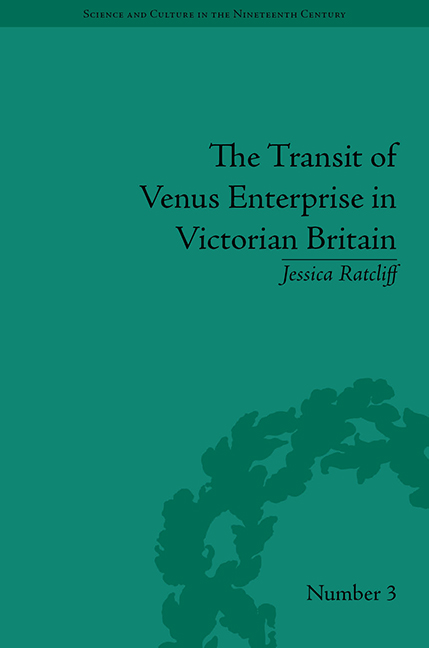Book contents
- Frontmatter
- CONTENTS
- Acknowledgements
- List of Illustrations
- Dedication
- Introduction
- 1 The Precedent: Transit of Venus Expeditions in 1761 and 1769
- 2 Big Science in Britain c. 1815–70
- 3 Noble Science, Noble Nation: The Establishment of Transit Programmes in Britain and Abroad
- 4 Inside Greenwich: The Preparations for 1874
- 5 The Expeditions
- 6 The Outcome
- Conclusion
- Epilogue: The Transit of 1882
- Notes
- Works Cited
- Index
3 - Noble Science, Noble Nation: The Establishment of Transit Programmes in Britain and Abroad
- Frontmatter
- CONTENTS
- Acknowledgements
- List of Illustrations
- Dedication
- Introduction
- 1 The Precedent: Transit of Venus Expeditions in 1761 and 1769
- 2 Big Science in Britain c. 1815–70
- 3 Noble Science, Noble Nation: The Establishment of Transit Programmes in Britain and Abroad
- 4 Inside Greenwich: The Preparations for 1874
- 5 The Expeditions
- 6 The Outcome
- Conclusion
- Epilogue: The Transit of 1882
- Notes
- Works Cited
- Index
Summary
But the facts are now patent; the scientific honour of our country is at stake.
The Times (London), 8 February 1873By the late 1850s, the Royal Observatory was running at the high level of efficiency for which, as was described in the previous chapter, Airy's tenure was already well known. After two decades as Astronomer Royal, Airy was a central and powerful figure in British science. He had not entirely avoided controversy. The recent loss of priority of the discovery of Neptune to the French was a huge blow to his public image. Airy's work on ship magnetism had brought him some notoriety as well; a ship was controversially lost just after its compasses had been adjusted according to Airy's method. It was from the operation of Greenwich meridian astronomy, however, that Airy maintained his upstanding character. There was a regular time service and a regular output of astronomical observations. Subjects on which the observatory steadily published included observations of minor planets, tables of the moon's motion, longitude determinations of foreign observatories, and refinements to the instruments of precision astronomy. Against this backdrop of routine observation, Airy introduced plans for attacking the problem of the sun's distance.
The value of the sun's distance (then referred to in terms of solar parallax), was continuously refined throughout the nineteenth century. During the 105-year gap between the eighteenth-and nineteenth-century transits of Venus, astronomers recalculated and reanalysed the 1761 and 1769 observations, sometimes when improved values of longitude for the observation stations were made available, sometimes when new approaches to the selection and combination of observations were developed. As the Edinburgh Review put it in 1873, ‘many restless astronomical spirits … continued to nibble at these figures’. In 1825, Johann Franz Encke produced a parallax of 8˝.54 (⋃154m km / 95.7m mi) by updating the longitude data for the results from the 1761 and 1769 transits. The British Nautical Almanac used this value from 1834 to 1869.
- Type
- Chapter
- Information
- The Transit of Venus Enterprise in Victorian Britain , pp. 35 - 56Publisher: Pickering & ChattoFirst published in: 2014



